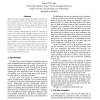Free Online Productivity Tools
i2Speak
i2Symbol
i2OCR
iTex2Img
iWeb2Print
iWeb2Shot
i2Type
iPdf2Split
iPdf2Merge
i2Bopomofo
i2Arabic
i2Style
i2Image
i2PDF
iLatex2Rtf
Sci2ools
88
Voted
ICPR
2002
IEEE
2002
IEEE
The Combining Classifier: To Train or Not to Train?
When more than a single classifier has been trained for the same recognition problem the question arises how this set of classifiers may be combined into a final decision rule. Several fixed combining rules are used that depend on the output values of the base classifiers only. They are almost always suboptimal. Usually, however, training sets are available. They may be used to calibrate the base classifier outputs, as well as to build a trained combining classifier using these outputs as inputs. It depends on various circumstances whether this is useful, in particular whether the training set is used for the base classifiers as well and whether they are overtrained. We present an intuitive discussing on the use of trained combiners, relating the question of the choice of the combining classifier to a similar choice in the area of dissimilarity based pattern recognition. Some simple examples will be used to illustrate the discussion.
Related Content
| Added | 09 Nov 2009 |
| Updated | 09 Nov 2009 |
| Type | Conference |
| Year | 2002 |
| Where | ICPR |
| Authors | Robert P. W. Duin |
Comments (0)

